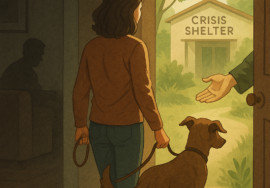
Escape to Safety: Crafting Your Lifeline from an Abusive Relationship

Leaving an abusive relationship is a daunting and dangerous journey, but it’s one you don’t have to navigate alone. A well-crafted safety plan can be your lifeline, providing the structure and resources needed to escape and build a safer, brighter future. Here, we’ll explore how to create a comprehensive safety plan that covers all the crucial aspects of leaving an abusive relationship. This guide combines expert advice with actionable steps to empower you on your path to freedom.
Understanding the Importance of a Safety Plan
A safety plan is more than just a set of instructions; it’s a personalized roadmap designed to keep you safe at every stage of your journey—from preparing to leave to starting your new life. Abuse can be unpredictable, so having a plan in place can help you make clear-headed decisions during high-stress situations.

Step 1: Preparation and Planning
Gather Important Documents
One of the first steps in your safety plan should be to gather all essential documents. This includes:
- Birth certificates
- Social security cards
- Driver’s licenses
- Passports
- Court orders and legal documents
Keep these documents in a safe place where your abuser cannot find them, such as with a trusted friend or relative (Psychology Today) (Canada.ca).
Financial Preparation
Financial independence is crucial when planning to leave an abusive relationship. Set aside some money, even small amounts, whenever possible. Consider opening a separate bank account that your partner is unaware of. Keep extra keys, cash, and a cell phone hidden and easily accessible (Psychology Today) (Canada.ca).
Identify Safe Spaces
Within your home, identify safe areas where you can retreat during a violent episode. These should be rooms with an exit and without potential weapons, such as knives. Practice your escape plan so you can act quickly if needed (Canada.ca) (Relationship Abuse Awareness).
Step 2: Building a Support Network

Trusted Contacts
Inform trusted friends, family members, or neighbors about your situation. Share your safety plan with them and arrange for them to call the police if they hear signs of abuse. Also, make sure they can take care of your children in an emergency (Psychology Today) (Verywell Mind).
Emergency Kit
Pack an emergency bag with clothes, toiletries, medications, and copies of important documents. Store this bag in a safe location, like with a trusted friend or family member (Psychology Today) (Relationship Abuse Awareness).
Step 3: During a Crisis

Immediate Safety Measures
During a violent incident, try to move to a room with an exit and avoid areas like the kitchen where weapons are accessible. If you are injured, seek medical attention immediately and ensure that the incident is documented (Canada.ca).
Step 4: Leaving the Relationship

Legal and Community Support
Consult with a lawyer who specializes in domestic violence to understand your legal rights and options. Contact local shelters and domestic violence organizations for support and resources. These organizations can provide invaluable assistance, from legal advice to safe housing (Psychology Today) (Relationship Abuse Awareness).
Children and Pets
Make arrangements for your children and pets to be taken care of during and after your departure. Teach your children how to call for help and establish a code word to signal them to seek safety (Canada.ca).
Step 5: After Leaving

Enhancing Security
Once you’ve left, take steps to enhance your security. Change your locks, phone numbers, and passwords. Inform your workplace about your situation and consider altering your daily routines to avoid being tracked by your abuser (Canada.ca).
Emotional and Mental Health
Leaving an abusive relationship is emotionally taxing. Seek counseling and support groups to help you cope with the emotional aftermath. Surround yourself with supportive people who understand your situation and can provide the emotional support you need .
A New Dawn: Your Path to Freedom and Safety
Creating a safety plan is a critical step in escaping an abusive relationship. By preparing meticulously, building a robust support network, and taking proactive steps to ensure your safety, you can embark on the journey toward a life free from abuse. Remember, you are not alone, and help is available. For personalized assistance, contact the National Domestic Violence Hotline or local domestic violence organizations, such as the Thompson Crisis Centre. Your safety and well-being are paramount, and with the right plan in place, you can achieve the freedom and peace you deserve. For more information and support, visit:


 Beyond Yes and No: How Building a Consent Culture Can Transform Our Communities
Beyond Yes and No: How Building a Consent Culture Can Transform Our Communities





